R.C. ROY¹ and B. BALL COELHO²
Agriculture and Agri-Food Canada, Delhi¹ and London², Ontario
Why plant a cover crop after corn?
It is well recognized that corn responds to nitrogen (N) applications and that corn yields vary considerably from year to year. The predominant factor for the variation in yield from year to year in southern Ontario is weather, particularly the amount of rain during the growing season. The effect of rain is amplified when corn is grown on sandy soils which have limited water storage capacity. This variability in growth potential due to summer rainfall results in substantial variability for the crop to utilize N in the soil. This is shown by the low grain yield response in dry years (1993 and 1999) compared to wet years (1994 and 2000) for corn grown on a sandy soil (Fig. 1). The years when there was limited response to increasing rate of N fertilizer application there was an increase in residual nitrate in the soil. This residual soil nitrate is vulnerable to leaching into the ground-water in late autumn and early spring.
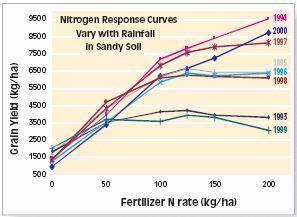
Figure 1. Variation in response by grain corn to applied N on a sandy soil in Ontario (for bu/ac multiply kg/ha X 0.0159).
Since it is not possible to predict the weather during the growing season, it is not possible to determine how much N fertilizer should be applied to the crop to ensure optimum growth and minimum residual nitrate in the soil after the crop is harvested. A winter cover crop can be used to take up the residual soil nitrate after corn has been harvested.
What cover crop is best?
Cover crops can be used for several purposes including minimizing erosion, increasing organic matter content in the soil and conserving N. Choice of cover crop should be based on its primary purpose. Non-hardy crops such as brasssicas, oilseed radish, oats and bin-run corn grow in the autumn but will be killed by winter conditions, releasing more than 50% of their tissue N in back into the soil. The released N is vulnerable to leaching in spring. Legumes can fix N from the air, thus potentially adding N to N-deficient soils. While forage grasses (perennial ryegrass, fescues and bromegrass) are good scavengers of soil N, these crops establish rather slowly so have limited capacity to take up N when planted after corn harvest. Interseeding ryegrass into corn has been successful in heavier soils of Quebec, but not in sandy soils of Ontario which become very dry in summer. Winter cereals, such as rye, appear to be the best cover crops for capturing residual N after corn in southern Ontario. Rye establishes and grows vigorously in the fall taking up significant amounts of soil N. Also, rye resumes growth early in spring.
When is the best time to plant rye as a cover crop for corn?
Seeding rye after grain corn has been harvested does not allow much time for substantial growth and use of soil N in the autumn. However, measurements in southern Ontario showed that rye planted into standing corn took up substantial residual N from the soil, especially during the dry years when the soil N was not utilized by corn (Fig. 2). Nitrogen uptake ranged from only 10 kg/ha (9lb/ac) after favourable corn seasons up to 50 kg/ha (45 lb/ac) after the dry summer of 1999 (Figs. 1 and 2), reaching 60 kg N/ha (54 lb/ac) by the following spring.
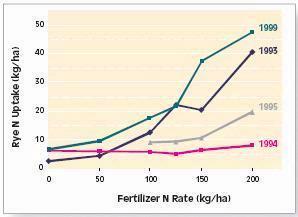
Figure 2. N-uptake by rye N (in November) increases with fertilizer N rate applied to corn, especially in dry years (1993 and 1999) when N uptake by corn is low (for lb/ac multiply kg/ha by 0.9).
Overseeding into an established corn crop in August may be the optimal method for establishing a rye cover crop. The rye generally becomes well established with late-summer rains, but does not compete with the corn for water, nutrients and light (Fig.3).

Figure 3. Cereal rye overseeded in August into standing corn grown using conventional tillage and 200 kg/ha (180lb/ac) of fertilizer N. Photo taken 21 Dec. 2001.
Measurements over three years have shown that regular overseeding in continuous corn reduced the amount of nitrate in soil water below the root zone (1.5 m or 5 ft depth) not only during late autumn and early spring but even during the following corn crop (Fig. 4).

Figure 4. Nitrate concentration in the soil solution (at 1.5 m or 5 ft depth) over 3 years in Norfolk County, Ontario with and without cereal rye overseeded into standing corn.
Does overseeded rye fit with conservation tillage?
Since rye resumes its growth in the spring, it has to be killed prior to replanting corn in the second year. In conservation tillage systems, the rye can be killed by cultivation. However, in no-till systems where the rye is killed by herbicide, there will be stubble both from the previous corn and the rye cover crop. Planters are now available with trash whippers to remove the residue from the planted row (Fig. 5).
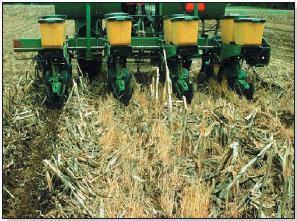
Figure 5. No-till planting into killed rye cover crop using trash whippers
Long-term effects of rye overseeding
Our research has shown that overseeding rye into grain corn can be effective in both conventional and no-till systems. On average, the N response curves shifted upward after rye relative to winter fallow under both conventional and no-till systems. The cover crop often boosted no-till yield above conventional tillage. Over a seven-year period, average corn (grain) yield was greater after overseeded rye than after winter fallow in both tillage systems, particularly when adequate fertilizer- N was provided (Fig. 6).
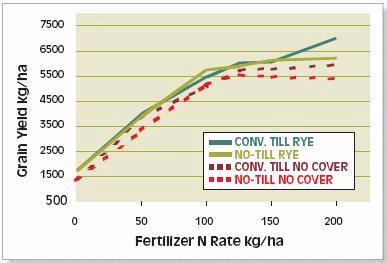
Figure 6. Long-term (7-year average) yield response curves for corn to N shift up with overseeded cereal rye cover crop in conventional and no-till (for bu/ac multiply kg/ha X 0.159).
The trend was for increased yield response to the cover crop over time. Yield advantage with long-term use of cereal rye cover crops has been reported also in Washington State and Holland. Some of the yield gain from the overseeded rye was probably due to improved soil properties, as indicated by improved wind-erodible and wet aggregate stability of the soil (Fig. 7). To avoid any potential yield depression with rye overseeding, the cover crop should be killed a week or two prior to planting, before the C:N ratio gets too wide (over 30). Early kill prevents the cover crop from tying up N, causing allelopathy or depleting soil moisture.
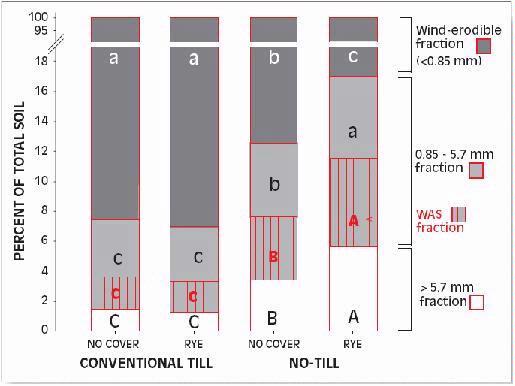
Figure 7. Soil wind-erodible fraction decreases and wet aggregate stability (WAS) increases with overseeded cover crop (after 5 years) under no-till.
How to overseed rye into corn
Seeding rye into a relatively mature corn field is an operational challenge. In our research trials, the rye was overseeded by hand. On a commercial scale, specialized elevated field implements, such as a Hi-boy, is one option for overseeding the rye. An alternative is to aerial seed from an airplane. As part of the Lower Big Otter Remedial project to reduce sediment loading into the Big Otter Creek and Lake Erie in Ontario, the Long Point Region Conservation Authority aerial-seeded rye into three established commercial corn fields in the watershed in the summer of 1997. Establishment of rye was generally good (Fig. 8) except where there were late-season grass escapes and spots in the field where soil pH was less than 4.
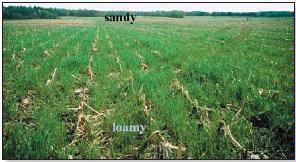
Figure 8. Cereal rye cover crop overseeded into standing corn (16 ha field) by aircraft as part of the Lower Big Otter Remedial Project, April 1998. Note effect of soil texture.
The overseeding did not affect corn grain yields in the year of rye seeding and corn grain yield was increased by 880 kg/ha (800 lb/ ac) in the subsequent year. The overseeded rye took up about 20 kg N/ ha (18 lb/ac) in the fall on all fields and noticeably reduced spring nitrate concentrations in the soil in two of the three fields (Fig. 9). Aerial seeding at 180 kg/ha (160lb/ac) costs about $74/ha ($30/ac), including $25/ha ($10/ac) for seed. Based on our long term experiment, overseeding costs would be paid back in 3-6 years thanks to increased yield of grain corn. There are additional benefits of cleaner drinking and surfaced waters and improved soil structure.
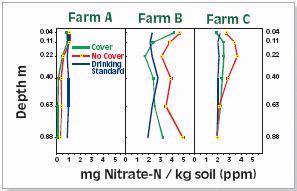
Figure 9. Nitrate-N in the soil profile to 0.9 m (3 ft) depth in spring as affected by a rye cover crop on 3 Ontario farms in 1998.
S. BITTMAN, D.E. HUNT and C.G. KOWALENKO
Agriculture and Agri-Food Canada, Agassiz, British Columbia
Importance of maximizing the growth period for corn
There is a dilemma for producers wishing to grow silage corn with little environmental impact. The crop is usually harvested four or more weeks after most nutrient uptake has ceased. Therefore, N mineralized after mid- to late August accumulates in the soil until it is leached by late autumn rains. Figure 1 shows the accumulated uptake of N by corn hybrids of varying maturity in coastal BC. Nitrogen remaining in the soil or mineralized after mid-August will be subject to loss over winter unless a winter cover crop is grown.
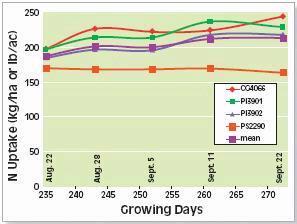
Figure 1. Effect of number of growing days and harvest date on N-uptake by silage corn hybrids varying in maturity in coastal BC. Silage corn removes very little N from the soil after August 22.
Cover crops can be planted after corn harvest to capture residual soil nutrients, especially N, and to reduce runoff and erosion. Unfortunately, the goal of maximizing corn yields conflicts with that of growing robust cover crops. The problem is that yield of silage corn, especially the accumulation of grain yield, is very closely tied to the length of the growth period for the corn. Advancing harvest reduces accumulated corn heat units and reduces grain yield regardless of corn hybrid, as shown in Fig. 2.
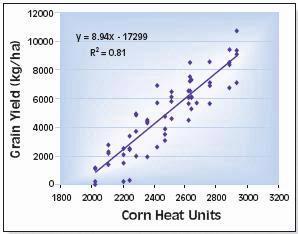
Figure 2. Effect of increasing accumulated corn heat units by delaying harvest on grain yield of 4 silage corn hybrids varying in maturity BC over 3 years (for bu/ac multiply kg/ha X 0.159).
Similar results were obtained from a study of 27 farms in coastal BC (Fig. 3). Here we see that over a range of soils, cultivars, management practices and pests on commercial dairy farms, over 50% of difference in grain yield of silage corn among fields could be attributed to the number of growing days for the crop. The growing period had less effect on whole crop yield and dry matter content at harvest than on grain yield. Good P nutrition improved grain yield and dry matter content at all planting dates. Note that the growing periods for corn crops ranged from about 110 to 150 days. Obviously, for over 200 days each year, many of them rainy, the soil lies bare and subject to runoff and leaching if no cover crop is planted.
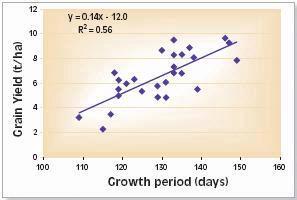
Figure 3. Effect of growth period from planting to harvest on grain yield of silage corn on 27 farms in coastal BC in 2002. About 56% of the variation in grain yield among all the farm
It is evident that farmers try to maximize yield by delaying corn harvest until days are short and the weather has deteriorated. Since growing conditions further decline after corn harvest, with each passing day that cover crop planting is delayed, the potential for growth and N-recovery by cover crops declines noticeably. Trials were conducted at Agassiz, BC to examine the decline in N-recovery by cover crops with delayed planting (Fig. 4). For the Aug. 22 cover-crop planting date, which is much earlier than corn is ever harvested, all crops took up 60- 95 kg/ha (lb/ac) of N (Fig. 5). By the Sept. 5 planting date, N grain corn uptake by both legumes fell off although uptake by the nonlegumes remained fairly constant. Even the non-legumes took up no more than 45 kg N/ha (lb/ac) after a Sept. 15 planting date. By Sept 20, no more than 30 kg of soil N can be recovered by the cover crop, regardless of species. These results show that planting date is a much more important factor than choice of cover crop for fall N-uptake, and that no fall-planted cover crop will remove much N from the soil when planted after late Sept. For late (after September) planting, fall rye is consistently the best performer, although this crop is rarely harvested for feed in spring by BC dairy farmers.
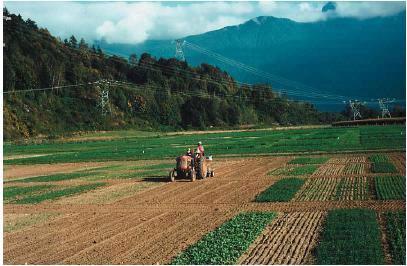
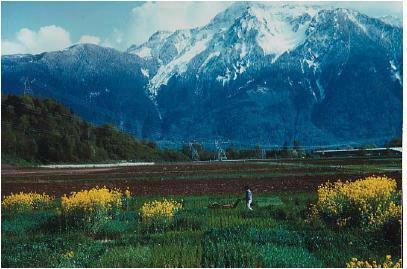
Figure 4. Trial at Agassiz BC testing the effect of planting dates (top) from Sept. 1 to Oct. 1 (strips) and cover crops (plots within strips) on fall N recovery and spring growth (bottom)

Figure 5. Effect of planting date on fall N-uptake by several cover crops in coastal BC.
Relay cropping
While the long period of bare soil seems to provide an opportunity for growth of a second crop, efforts to fully exploit the growing season for production of silage corn necessarily result in less favourable conditions for the cover crop. Of the 110 -140 days that a corn crop is in the ground, there are at least 30 days in which the canopy is small and open and much of the ground exposed to sunlight. The after-planting period when the corn canopy is open represents additional time with good growing conditions to grow another crop, provided that it does not compete with the corn. This is the thinking behind the concept (see Whole Farm Nutrient Management section) of ‘relay cropping’ which developed in BC, the Netherlands, and other places. Relay cropping is currently being carried out by many of the corn growers west of the Cascades in BC, Washington and Oregon (Fig. 6).
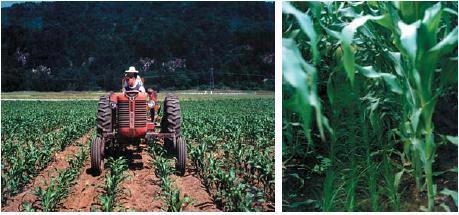
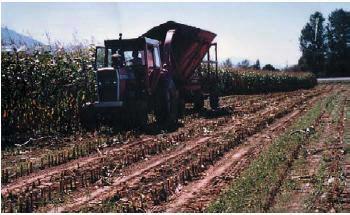
Figure 6. Relay crop trials at Agassiz BC in the early 1990’s showing planting at 6 leaves (top left), growth between corn rows (top right) and corn harvesting with inevitable wheel damage (bottom)
Relay cropping is designed to establish the winter cover crop while the corn is very small, to take advantage of the open canopy, so that the cover crop is well established by the time the corn is harvested (Figs. 6-7). A successful relay crop must be able to persist in the shade and humidity under the closed corn canopy and withstand probable disease burden and dry soils. There must also be compatible methods for weed control, and the relay crop must be tolerant of wheel traffic during the corn harvesting 0peration. Several crops that failed to withstand prolonged periods under corn in our trials include fall rye, winter wheat, winter canola, typhon rape, hairy vetch and crimson clover. The two crops that did persist were Italian ryegrass and red clover. Of the different types of Italian ryegrasses, we found that the tetraploid biennial varieties performed better that the diploid biennials which in turn were better than the Westerwold annual types.
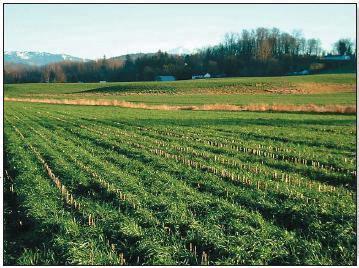
Figure 7. Relay-crop at Kambro Farms in Matsqui, BC on 7 Jan 2003.
After evaluating candidate crops, we performed a series of experiments to determine best cropping practices to establish the relay crop including optimum corn population density, optimum growth stage of corn for planting the ryegrass and the impact of date of corn harvest on producing a successful relay cover crop. The purpose of the relay crops was to:
- capture the maximum amount of residual soil nitrogen in the fall
- provide ground cover to protect against erosion and runoff
- produce enough yield in spring to offset the cost of growing the relay crop and decrease the need for purchased feed, hence reducing importation of nutrients to the farm (Fig. 7).
Figure 8 shows that reducing corn population from the standard 75,000 per ha (30,000 per ac) to 55,000 per ha (22,000 per ac) reduced yield of corn by about 1,500 kg/ha (lb/ac). As expected, a significant yield loss was caused by advancing harvest by 2 weeks (from late Sept. 20-25 to mid Sept. 7-10). The relay crop itself had very little effect on yield of corn. Even if ryegrass was planted when the corn had only 3 leaves, there was only about 500 kg/ha (lb/ ac) reduction in corn yield compared to the planting into 6- to 9-leaf corn. The inter-planting operation seemed to slightly increase corn yield over the control, possibly due to the soil disturbance caused by the double-disk openers which might have led to release of nutrients. Red clover planted at 6 leaves also had a very slight positive effect on yield of corn.
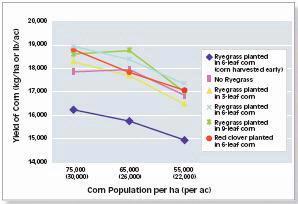
Figure 8. Whole-crop yield of silage corn as affected by corn population, corn harvest date (mid- or late Sept) and relay crops planted at different corn growth stages (mean of 6 trials 1993-95) fields was related to length of growth period.
The amount of ryegrass growth that occurred up to corn harvest (Fig. 9) ranged from 300 to 1200 kg/ha (lb/ac) (Fig. 10). Growth of ryegrass under the corn was enhanced by low corn populations, planting the ryegrass early and harvesting the corn early. Red clover produced less than a third the biomass of ryegrass. At this time roots produced about 60 to 80% the amount of biomass as the tops. The ryegrass contained 15-25 kg/ha (lb/ac) of N in the shoots and 5-10 kg/ha (lb/ac) of N in the roots.
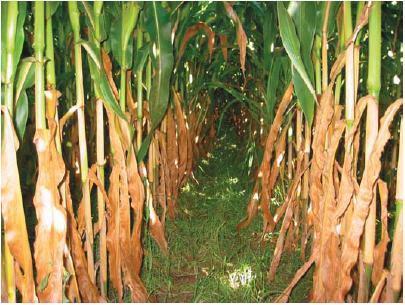
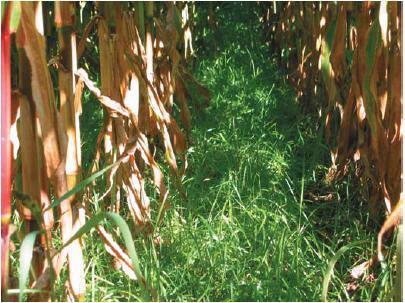
Figure 9. Moderately (top) and well established (bottom) Italian ryegrass relay crop in a corn stand
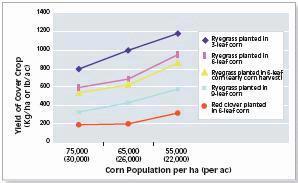
Figure 10. Yield (above ground) of Italian ryegrass and red clover relay crops at time of corn harvest at Agassiz, BC (mean of 6 trials 1993-95). The relay crops were planted at different corn growth stages and corn populations. Corn was harvested in late Sept. except for one ryegrass treatment (early to mid Sept).
When the corn was harvested, the ryegrass was subjected to damage from wheel traffic and, immediately after harvest, to stress from sudden exposure to full ambient light and wind. As a result, the ryegrass grew slowly for 1-2 weeks after corn harvest before resuming more rapid growth. Ryegrass growth continued well into autumn as the grass does not tend to become dormant. Similarly, uptake of N continued through the autumn so that by early to mid-November, herbage of ryegrass relay crop contained 18-61 kg/ha (lb/ac) of N (Fig. 11a) and the roots contained another 10-20 kg/ha of N (not shown). By contrast, both the fallplanted fall rye and ryegrass had taken up less than 10 kg/ha (lb/ac) of N in both tops and roots combined. The red clover relay crop took up less than half the N as the ryegrass.
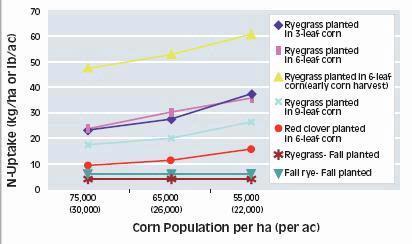

Figure 11. (top) Fall N-uptake (above ground) by relay crops and fall planted cover crops and (bottom) yield of relay crops and conventional cover crops in late April after application of spring fertilizer at Agassiz, BC (mean of 6 trials 1993-1995).
The cover crops were supplied with 55-60 kg/ ha (lb/ac) of N in early spring. By the end of April, herbage yield of the cover crop ranged from 2000 to 3400 kg/ha (lb/ac) (Figure 11b). Best yields were obtained from the plots with early corn harvest and thin corn populations. Ryegrass planted into standard corn populations yielded almost 50% more when the corn had been harvested in mid Sept. Fall planted crops yielded significantly less than the relay crops. Red clover yields in late April were quite low.
Conclusion
Relay cropping has several advantages over conventional fallplanted cover crops. They take up much more N in the fall although the capacity for fall uptake does not usually exceed 80 kg/ha in tops and roots. This means that the crop helps to take up residual soil N but should not receive manure or fertilizer in the autumn, except where fall growth has been particularly prolific. The cover crop not only captures N, it provides cover against soil erosion and nutrient runoff over winter. In the Fraser River Delta, the relay crop has been shown to provide winter grazing for water fowl and to lure them away from perennial forages which they frequently damage. Yield of the ryegrass relay crop in spring is economically significant provided that the crop receives a spring application of manure or fertilizer. Red clover is less effective for fall nutrient capture and for spring forage production. The additional feed reduces need for purchased feed and the nutritional quality of the grass is excellent when harvested in April before replanting corn. Relay crops that are ploughed-under are useful for reducing runoff and erosion but do not help the overall farm nutrient balance as much as fed relay crops.
Cover crops may affect growth of subsequent corn crop</h3<
While the growth period of corn affects when the cover crop can be planted and even which cover crop is most suitable, the cover crop itself may affect subsequent corn crops. Cover crops will absorb nutrients from the soil in spring and these nutrients are either returned to the soil if the cover crop is ploughed down or largely removed if the cover crop is harvested. A study was conducted at Agassiz to determine how different harvested cover crops affect the response to N of subsequent corn crops. Figure 12 shows that that corn yield after most cover crops (winter wheat, fall rye and Austrian winter peas) was similar to growth after winter fallow. That N response was not different after these cover crops compared to bare soil indicates that most of the N in the bare soil was lost over winter. The exception to this pattern was Italian ryegrass. At low N rates, corn did not grow as well after Italian ryegrass as after the other three cover crops, probably because the ryegrass took up more soil N over the winter.
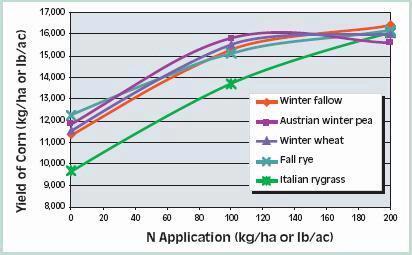
Figure 1. Response of whole-crop yield of silage corn to nitrogen fertilizer after several winter cover crops in coastal BC (1993-95).
S. Bittman¹ and O. Schmidt²
¹ Agriculture and Agri-Food Canada, Agassiz, BC, and ² British Columbia Ministry of Agriculture, Food and Fisheries, Abbotsford, British Columbia
Planting corn
Plant corn early, in late April to early May. This will allow you to harvest the corn early, one of the most important factors for success. Early (low heat unit) corn hybrids will facilitate early harvest. Pay very close attention to heat-loving annual weeds, especially if planting after mid-May.
Use normal corn populations of 75,000 plants per ha (30,000/ac). The ryegrass will perform better where the corn population is thin, but reducing corn density to favour the ryegrass is not economical.
The ryegrass usually performs best near the perimeter of a field because of better light penetration. Relay crops around fields may serve as filter strips to reduce runoff into waterways.
Planting ryegrass
Plant ryegrass when the corn has 3-6 leaves. Ryegrass planted before 3-leaves may suppress the corn, while ryegrass planted after 6-9 leaves will be suppressed by the corn. Plant ryegrass at 25-30 kg/ha (22-27 lb/ac). Plant in strips between corn rows to save seed because little ryegrass will grow in the corn rows. Best ryegrass establishment occurs with drilling but this takes longer and is rarely done. Irrigation may help the ryegrass establish and survive.
Ryegrass varieties
Tetraploid, biennial varieties of Italian Ryegrass varieties persist more consistently under corn than diploid which in turn are better than annual Westewold varieties.
Weed control
Inter-planted Italian ryegrass will not persist in weedy corn fields. Warm-season grassy weeds will compete very aggressively with the cool season ryegrass in the heat of the summer. Non-residual herbicides are available for pre-plant and postplant control of both grassy and broadleaf weeds prior to planting the ryegrass. Inter-row cultivation at time of planting will provide some weed control (see Weed Control section).
Harvesting the corn
It is very important to harvest the corn as early as possible to provide light to the ryegrass. By advancing corn harvest by 10-14 days, fall growth of the ryegrass may be increased by over 30%.
Some tire traffic damage is inevitable, especially in the headlands, but this is minimized by driving as much as possible over the corn rows where there is usually little ryegrass.
Fertilizing the cover crop
Fertilizing the relay crop in autumn is usually unnecessary because of the residual soil N after corn harvest. A well-established relay crop may require spring application of manure or fertilizer for rapid spring growth and early harvest.
Winter-hardiness
Some ryegrass varieties are as winter-hardy as many winter wheat varieties, but less hardy than fall rye. Very small plants are less tolerant of low temperature, heaving and desiccation than well-rooted plants.
Flooding tolerance
Small ryegrass plants will withstand flooding for no more than 1-2 weeks.
Using the ryegrass
Italian ryegrass is reputed to be among the highest quality cool season grasses. Ryegrass is very well suited to grazing, and cows can be put out early because of its early growth in spring. Damage to the stand or compaction of wet soil is relatively unimportant since the field will usually be cultivated again for corn.
Ryegrass also makes good green-feed and silage, although it is difficult to cure. In coastal BC and the Pacific Northwest, relay ryegrass may yield 3000-5000 kg/ha (lb/ac) by mid-April, before corn would be replanted.
Late fall grazing would rarely be possible in Canada but may be an option in milder regions of the US, Europe and elsewhere.
Well-established relay ryegrass is sometimes harvested through the next summer.
Eliminating the stand in the spring
Non-selective herbicides may be used to kill the ryegrass in the spring prior to replanting corn although they may not be fully effective. Using herbicide resistant corn hybrids allows use of non-selective herbicides against surviving ryegrass after the corn is planted. Ploughing or disking, then allowing some rotting of the sod is helpful. Intense grazing prior to ploughing will reduce crop residue.
Effect on subsequent nutrient requirement of corn
Requirements for nutrients, especially N, by corn will increase substantially following a relay crop, giving greater opportunity for use of slurry manure.
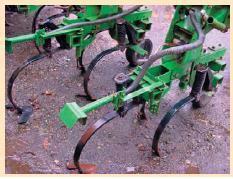
Tool used to cultivate between corn rows and seed relay crops in western Washington.
L.J.P. VAN VLIET¹ and B.J. ZEBARTH²
Agriculture and Agri-Food Canada, ¹ Agassiz, British Columbia, ² Fredricton, New Brunswick
Runoff from corn land during the wet fall and winter season presents a concern for surface water quality, especially if manure is applied after corn harvest. In the Lower Fraser Valley of British Columbia, about 1100 mm (43 in) precipitation falls between November and April, mostly as rain. We conducted a field study to determine if relay crops would reduce surface-runoff and nutrient loss from a corn field after surface application of liquid dairy manure in autumn.
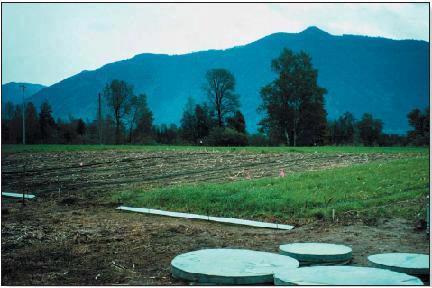
Figure 1. Field trial at Agassiz, BC for evaluating the effect of a relay crop on reducing nutrient runoff from surface applied liquid dairy manure.
The experiment was conducted on a 3-5% slope at the Pacific Agri-Food Research Centre in Agassiz, BC from 1996 to1998. On half the plots, Italian ryegrass was planted as a relay crop when the corn was at the 6- to 9-leaf stage (late June to early July). Runoff, solids, and nutrients loads from natural precipitation were measured systematically over the fall and winter period.
Without a relay crop there was a high risk to surface water quality, due to high loadings of suspended solid (7-14 t/ha or 3-7 T/ac) and the nutrients N (98 kg/ha or 90 lb/ ac), P (21 kg/ha or 19 lb/ac) and K (63 kg/ha or 55 lb/ac). The relay crop reduced the mean annual runoff by 53% and loading of suspended solids by 74% (Table 1). The relay crop also reduced N loading by 56%, P loading by 42%, and K loading by 31%.
Table 1. Effect of relay crop in reducing over-winter runoff, solids and nutrients from a silage corn field receiving broadcast dairy slurry in fall in south coastal BC
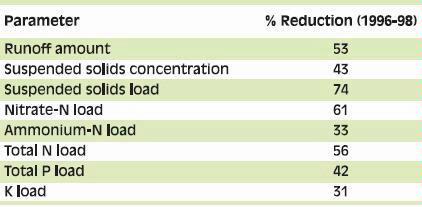
Relay cropping is recommended as a beneficial, sustainable management practice for silage corn grown on sloping land in high rainfall areas of the Pacific Northwest. Relay crops are particularly useful in adding to buffer strips near water courses. It is helpful that the relay crop tends to grow best around the perimeter of a field, because of better light penetration, provided that traffic during harvesting is minimized.
